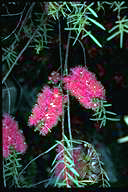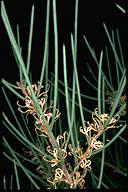

 |
Australian National Botanic Gardens
|
 |
A weekly news sheet prepared by a Gardens' volunteer.
Numbers in square brackets [] refer to garden bed Sections.
Plants in flower are in bold type.
21 May 2004
 |
|
Melaleuca radula
- click for larger image
|
This walk commences at the nursery and continues into the mallee area. Walking to this area includes many colourful plants as do those along Banks Walk and those through- out the Rock Garden. On the way note a bottlebrush, Callistemon ‘Glasshouse Country’ [Section 110] bearing rosy-pink flowers spaced out on the upright shrub, Hakea laurina [Section 20] well covered with golf ball size deep red flowers and Leptospermum squarrosum [Section 44] with branches crowded with open pink flowers.
Edging this uphill road, ground covers include Chrysocephalum apiculatum [Section 300] dense with grey foliage and dotted with small orange button flowers, Grevillea lanigera [Section 300], also dense with pink and white spider flowers and Brachycome ‘Breakoday’ [Section 300] with softer foliage and small mauve daisies.
On the opposite side of the road the floral emblem of NT, Sturt’s Desert Rose, Gossypium sturtianum [Section 100] is still small, displaying pink-purple hibiscus-like flowers. Eremophila maculata [Section 100] is glowing yellow with bugle-shaped flowers over a neat shrub, while Melaleuca radula [Section 100] is rather lanky, beautified with a sprinkling of pink fluffy flower balls.
 |
|
Hakea cycloptera
- click for larger image
|
On either side of the boardwalk in this mallee area are Gastrolobium propinquum [Section 100], a dwarf plant bearing small yellow and red pea-shaped flowers, Eremophila bignoniifolia x polyclada [Section 100] a medium spreading shrub well covered with large white bugle-shaped flowers with a tint of mauve and a dark spotted throat. Beside it is a patch of small plants of Lechenaultia biloba [Section 100] bearing powder blue flowers. The small shrub well covered with small pink lacey flowers is Hypocalymma sp. [Section 100]. At the curve Grevillea stenomera [Section 100] is a large spreading shrub with yellow-tipped red somewhat toothbrush-like flowers. Eremophila subfloccosa subsp. subfloccosa [Section 100] is a rather odd looking dwarf woolly shrub with curved light green tubular flowers almost concealed in the foliage.
Banksia epica [Section 100] is a low dense shrub with flower-spikes of all ages from tiny juvenile flower-spikes to mature light ochre with dark styles. Eremophila oppositifolia [Section 100] continues to bear white, with a tint of mauve, tubular flowers over a shrub of medium size. Shining from the garden centre, Beaufortia decussata [Section 100] displays it lovely red flower-heads along the long upright branches with small uniform leaves. Edging the path, Scaevola phlebopetala [Section 100] shows off its bright yellow-centred purple flowers along its trailing stems. Banksia ornata [Section 100] brightens this upright shrub with lemon flower-spikes dotted with grey styles. Correa reflexa var. scabridula [Section 100] has red and ochre coloured tubular flowers along its low lateral branches. A patch of dwarf plants, Goodenia varia [Section 100] are bright with yellow flowers while Hakea cycloptera [Section 100] is a neat rounded shrub with lacey flowers growing from base to tip. At the exit Pimelea ferruginea [Section 100] has a cover of pink flowers in clusters covering this rounded shrub, and opposite, the grand old Banksia ericifolia var. ericifolia [Section 103] exhibits its rich golden flower spikes.
Worth the walk …
Barbara Daly.